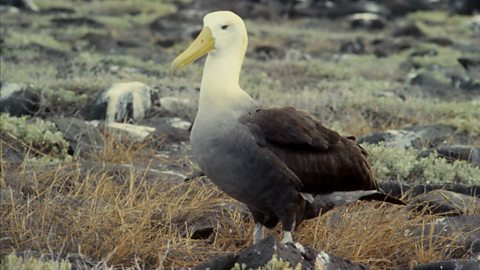Key points
- All organisms in an ecosystem depend on each other.
- Food chains show the flow of energy from one organism to another.
- Food chains show the feeding relationships between organisms.
- Food webs show how all the food chains in an ecosystem interact.
Food chains
Video - Food chains and ecosystems
A food chain shows the feeding relationship between organisms. They always start with an organism that makes food. The producer. In this example, it's grass.
The first consumer in the chain, in this case the grasshopper, is also called the primary consumer. A consumer that only eats plants is called a herbivore.
The frog is the secondary consumer. Because it only eats other animals, it's called a carnivore.
The hawk is the tertiary consumer and, in this chain, the term given to the organism found at the top of a food chain, which is not preyed upon.
It is important to remember that the arrows in food chains show the flow of energy from one organism to another.
On planet Earth, there are many different food chains that often overlap and interconnect, that play their part in the world's ecosystems.
Can you answer these questions based on the video?
1. What does a food chain start with?
2. What is shown by the arrows in a food web?
- A producer, which is often a plant.
- The flow of energy.
Ecology
Ecology is the study of living organisms and the places that they live. An ecologist studies the number and distribution of living organisms in an ecosystemA community and the habitat in which organisms live.. Knowing this is essential to allowing us to protect the organisms that need help to survive.
Trophic levels
A food chain is a list of organisms in a habitatThe place where an organism lives. that shows their feeding relationship, i.e what eats what. The organisms are joined by arrows which show the transfer of energy in food between them. The stages in food chains are called trophic levels.
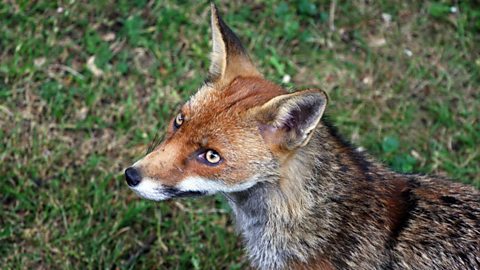
Food chains always start with a producer. This is usually a green plant or algae that completes photosynthesisA chemical reaction that occurs in the chloroplasts of plants in which the energy in light is stored in glucose. to store energy from sunlight as glucose. Grass is the producer in the grass → rabbit → fox food chain. Photosynthesis provides the energy for most life on Earth.
A primary consumer eats a producer. The rabbit is the primary consumer in the example food chain. This is in turn eaten by a secondary consumer, which is the fox.
After this might be a tertiary consumer (which eats a secondary consumer) and possibly a quaternary consumer (which eats a tertiary consumer), but not in this example.
Animals that are hunted and eaten are prey, and these are consumed by predators. The final consumer at the top of the food chain is called a top (or apex) predator and is not eaten by anything else.

What is the final consumer in this food chain?
The hawk is the final consumer, or apex predator, in this food chain.
Volcanic vents
There are volcanic vents at the bottom of the oceans where it is so dark that no plant or algae could live. Places like this are the only food chains on Earth that don’t start with photosynthesis.
The producers are bacteria which feed directly on the chemicals released from the vents and use a variety of chemical reactions to make glucose. This process is called chemosynthesis.
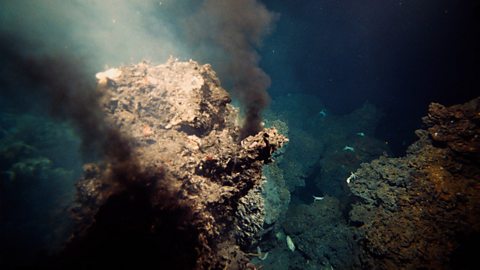
Video - Where does energy come from?
DISTANT VOICE: Food comes from space!
NARRATOR: Well, sort of. Pizza doesn't come from Mars it originally comes from Italy, but if we look at something called a food chain we can see that all the energy animals get from their food originally comes from around 93 million miles away.
Is that possible? Can you guess where that could be?
Yes, it's the Sun.
So what happens to the Sun's energy when it reaches Earth?
Well, green plants convert the Sun's rays into energy through a process called photosynthesis. Almost all food chains begin with a green plant.
Here in the sea, seaweed and plankton do the job. A plant that converts the Sun's rays into energy is called a producer. They are the start of a food chain. Animals get all the energy and nutrients they need to live from eating other plants and animals. The animals that eat the producers are called primary consumers.
These little guys munch on the plankton like a caterpillar eating grass or leaves. Animals that eat the primary consumers are secondary consumers. The primary consumer is prey and the secondary consumer is the predator. But predator can become prey.
This is the strange but amazing frogfish. Nothing else eats frogfish apart from sometimes other frogfish!
An animal that isn't eaten by anything else is the top predator in a food chain.
So we can see how the energy from the Sun is converted by plants then moves up the food chain to the top predator. These are some plants and animals you might be more familiar with.
How would they fit into a food chain? What eats what and where does the energy come from to start with?
You can see how the energy from the Sun moves up through the food chain to the top predator.
The eggs laid by this Peregrin falcon are weak and damaged. But what's caused it?
Amazingly, it was a pesticide called DDT used around 50 years ago to kill insect pests and protect crops. But how did this happen?
A food chain can show us.
The DDT was taken in by plants or insects. These were then eaten by birds who in turn were eaten by Peregrin falcons which caused their eggs not to grow properly and have thin shells. So, just like energy, if a poison enters a food chain it is passed along and has knock-on effects on all the animals up the chain.
What do you think would happen if one plant or animal in a food chain was removed?
If there is nothing to eat a consumer its population can grow out of control. In many parts of Britain this is happening to the deer population.
We don't have wolves in Britain anymore so the deer have no natural predator that eats them. Deer eat woodland shrubs and undergrowth.
So if there are too many of them it can cause a lot of damage to the habitat of other animals like woodland birds. They are also destroying important woodland plants. When one population is out of control, it can effect many others.
Most animals don't just eat one thing. In any ecosystem there are lots of food chains that all link together. This is called a food web.
A food web is all the food chains that make up an ecosystem from producers to consumers to top predators. But here's a question. What happens to the energy and minerals in the top predator? Is it the end of the story? Well no.
As always, someone is left to tidy up. In a food chain these are the decomposers. They consume dead animals decaying plant material and waste products from other members of the ecosystem and return the nutrients to the soil which helps the green plants to grow and the whole food chain to begin again.
With a little help from 93 million miles away.
Can you answer these questions based on the video?
1. Where does almost all the energy in food chains originally come from?
2. What is an animal that isn’t eaten by anything else called?
3. What do lots of food chains make?
4. What eventually happens to the top consumer?
- The Sun.
- An apex (or top) predator.
- A food web.
- They die and rot returning the nutrients to the soil or are consumed.
Food webs
Most populationAll the members of a single species that live in a habitat. of organisms that live in a habitat usually have more than one food source. They usually consume more than one organism from the trophic level below. This means that there are almost always more than one food chain and these are interlinked into a food web.
This food web is made up of lots of food chains, including:
- grass → insect → vole → hawk
- grass → insect → frog → fox
- grass → insect → vole → fox
Some organisms, like the rabbit and slug, have just one consumer. Others, like the frog and vole, have two.
Which animal has three consumers?
The insect.
Toxic materials in the food chain
Toxic materials are poisonous. Some quickly break down into harmless substances in the environmentAll the conditions that surround a living organism.. Others are persistent (they stay in the environment and do not break down). These substances accumulateTo increase in amount or concentration, especially in one place. in the food chain and damage the organisms in it, particularly in the predators at the end of the chain. This is because accumulating compounds cannot be excreted.
In the past, mercury compounds were used to make insecticides (substances that kill the insects that damage crops), and special paints that stop barnacles growing on the hulls of ships.
Unfortunately, when mercury gets into a food chain, it damages the nervous systemBody system that includes the brain, spinal cord and nerves. and reproductive systemThe organs and tissues involved in producing offspring. of mammals, including humans. The diagram shows how mercury can accumulate in the food chain.
In the sea, tiny animals and plants called plankton absorb the mercury compounds. When the plankton are eaten by small fish, the mercury they contain stays in the fish. As the fish need to eat a lot of plankton, the concentration of mercury in them becomes higher than its concentration in the plankton.
Larger fish eat the small fish, and larger ones still (such as tuna fish) eat them. This creates a high concentration of mercury in the tuna. People eating contaminated tuna may get mercury poisoning. Mercury is now banned from many chemical products and mercury use in industry is carefully regulated.
Test your knowledge
Teaching resources
Are you a teacher looking for more resources for your lessons? This video from the Biology with Dr. Chris van Tulleken series explains key scientific concepts and processes related to energy, food chains and food webs.
BBC Teach has thousands of free, curriculum-linked resources to help deliver lessons - all arranged by subject and age group.
GCSE exam dates 2025
Find out everything you need to know about the 2025 GCSE exams including dates, timetables and changes to exams to get your revision in shape.

More on Ecosystems and habitats
Find out more by working through a topic
- count2 of 7
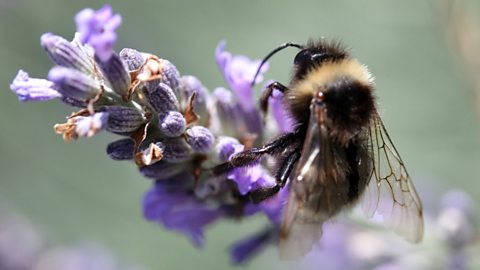
- count3 of 7
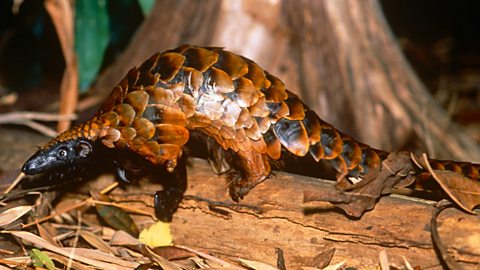
- count4 of 7
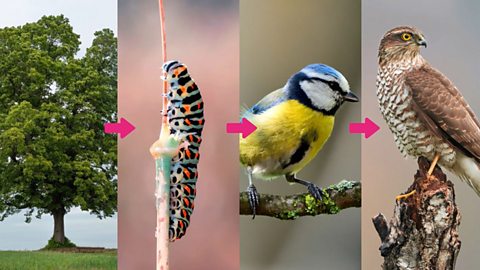
- count5 of 7
